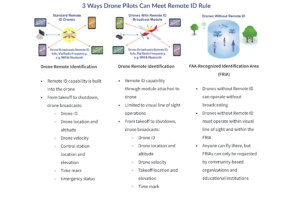Is CISA’a advice for ECCs accurate? DSPA doesn’t think so.
When there is a citizen concerned about drone activity, there is a pretty good chance their first reaction would be to call their local Emergency Communication Center (ECC). As drone pilots ourselves, and having spoken to many law enforcement and city councils, DSPA can certainly corroborate that theory.
And making sure those 911 Operators are trained correctly on how to handle those calls is critical to keeping the public from panicking. And just as important, those 911 Operators need to keep the drone operators safe.
The Communications and Infrastructure Security Agency (CISA) recently published a pamphlet designed to help 911 Operators when those drone call come in from concerned citizens.
DSPA feels this pamphlet may have done more harm than good. Well intentioned for sure, but much too broad in it’s attempt to help the uniformed public on what to look for when it comes to what a suspected suspicious drone operation looks like.
And therein lies the problem.
First off, if a citizen has an issue with a drone operating near them, odds are they’re fairly uninformed in actual drone use. So right off the bat, they’re likely operating under a false notion of what the drone is actually doing. Piling on with fear based questioning will only make the situation worse. And possibly put the operator in danger.
And a little sidebar is necessary here. Human nature tends to fear what they don’t know. Just think of all the cell phone fears when they first came out. If you went into any locker room when cell phones first came out, there was usually a basket to place your phone in, or you left it with the locker room attendant.
Today, now that cell phones are so common place, no one thinks twice about someone walking through a locker room while talking on the phone.
With any luck, in time that same attitude will transfer over to the UAS world. So until then, drone pilots will continue to be the operators of misunderstood tech.
Which is why it’s so important for the first line of communication with the general public to have a very good command of actual, every day drone use. They do not need to feed the paranoia and fear likely already front in the minds of the callers.
How does CISA’s ECC pamphlet make things worse?
First, CISA seems to use a very broad brush to paint the picture of a suspicious drone flight.
The second graphic on the front of the pamphlet is titled “What does a suspicious drone flight look like?”
Some of it CISA sort of got right, such as taped over lights, or erratic or uncontrolled flight. Those are certainly characteristics of a possible suspicious flight. But even that flight description isn’t really that accurate. They’ve obviously never seen an FPV drone with a great pilot at the controls.
But the very misleading bullet points are the 2nd, 4th, and 5th bullet points. Each of those describe perfectly legal and safe flights. And they describe the vast majority of both recreational and non-recreational flights.
Bullet point 2 describes “flight patterns or hovering around a fixed site” as suspicious. This bullet point has to be the most egregiously inaccurate one. Basically because those very words describe our day in and day out flights. Virtually every flight we take would fall into this category.
Bullet point 4 mentions suspicious payloads. The person calling 911 about drones likely isn’t going to know what a suspicious payload looks like if it landed on top of them. CISA uses the terms “oddly-shaped” and “weapons, or contraband”. I wonder what a person without UAS knowledge would think of a Zenmuse X7 hanging under an Inspire 2? “Contraband”?
And bullet 5 talks about not being able to see the operator.
We don’t know about you, but during the vast majority of our flights, unless someone is standing within a block or two of us, they’ll have no idea where we are. At least until Remote ID becomes mandatory.
Simply not being able to see the operator, having a consistent flight patter (or heaven forbid stopping and taking photos), and flying a UAS with a “suspicious” payload should not be reason to elevate a fear-filled 911 caller into a frenzy.
Yes, the top bullet point on the back of the pamphlet says “Do not take any action to ‘down’ the drone or interfere with its flight. Such actions could endanger you and others and violate federal/state/local laws.” And we sincerely thank CISA for that.
But DSPA honestly believes that the first and foremost job of a 911 operator must be to defuse the situation, NOT increase the caller’s fear in the first place.
The first thing out of a 911 Operator’s mouth should be a reassuring comment about how it’s very unlikely that the drone operator is doing anything illegal or dangerous. Then they can go into getting a description of what the drone is doing. Simply flying around in patterns or hovering over a site is NOT cause for concern. It shouldn’t even be part of the question.
The first line on the back of the pamphlet is, “When receiving a call about drone activity, it is vital to ensure the caller’s safety. Once the caller is safe and out of danger, it is important to focus on obtaining a detailed record about the drone, its activity, and any impacts.“
No, it’s not “vital”. It’s incredibly unlikely that the caller is in any danger at all. It’s much more likely the drone operator is in danger due to the fear of drones. And the questions in the CISA pamphlet can very well aggravate that situation.
Once you get past the opening script sentence written by CISA, the pamphlet starts to make sense. There are some good question to ask, whether the drone is in the air, or laying on the ground.
But even some those seem to be a little geared towards the perceived danger of drones, and the possibility (probability) that drone operators are the bad guys (& gals).
Yes, a correctly trained 911 Operator can diffuse an ill-informed called who is scared by a drone. But CISA’s pamphlet is not the vehicle to use for training. It will most certainly cause more issues than it will ever prevent.
We urge CISA and the FAA to work with the drone community to craft a more realistic and accurate method of helping educate Emergency Communication Center operators about drones. Because that will help keep the drone operators safe.
Education is the key.



